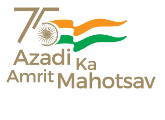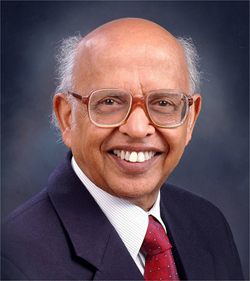Professor Govind Swarup, F.R.S.
Dr Govind Swarup is an internationally well known pioneer in the field of radio astronomy. In addition to his many research contributions, he is also known for building ingenious, economical and powerful observational facilities for front-line research in radio astronomy, namely, the Ooty Radio Telescope (ORT) in South India and the Giant Metrewave Radio Telescope (GMRT) near Pune, that are amongst the largest in the world.
Govind Swarup was born at Thakurdwara, Uttar Pradesh in 1929. He received B.Sc. degree in 1948 and M.Sc. in Physics in 1950 from the Allahabad University and Ph.D. from Stanford University in 1961. He was awarded Doctor of Engineering (Honoris Causa), Roorkee University in 1987 and Doctor of Science (Honoris Causa), Banaras Hindu University in 1996. He was at the National Physical Laboratory, New Delhi (1950-53 and 1955-56), CSIRO, Australia (1953-55), Research Associate at Harvard University (1956-57), Research Assistant at Stanford University (1957-60) and Assistant Professor at Stanford University (1961-63). At the invitation of Dr Homi Bhabha, he joined the Tata Institute of Fundamental Research (TIFR), in 1963 as a Reader and retired as Professor of Eminence in 1994. He was Project Director, GMRT (1987-96) and Centre Director of the National Centre for Radio Astrophysics of TIFR, Pune (1993-94). He spent six months each as a visiting Professor at the University of Maryland, Groningen and Leiden during 1980-1981.
Some of his pioneering contributions are: discovery of Type U solar radio bursts, gyro-radiation model for microwave radio emission from solar active regions, a modulation technique for phase adjustment of large antennas and studies of radio galaxies and quasars. From lunar occultation observations using the ORT, high angular resolution studies (about 1 to 10 arc sec) of more than 1,000 weak radio galaxies and quasars were made for the first time in the world by him and his students during 1970s. He discovered a relation between the angular sizes of radio sources and their flux density which provided an independent support for the Big Bang model and evidence against the Steady-State model of the Universe. Swarup is currently making observations with the GMRT for problems related to cosmology.
He has written 125 research articles; guided 23 Ph.D. students; edited 4 books and has two patents on: (a) A fixed mirror line focus Solar Concentrator; and (b) Preloaded Parabolic Dish Antenna & the Method of Designing it. In 1995, he and Professor V.G. Bhide proposed a 5-year integrated programme for intensive education in science after 10+2 schooling, resulting in setting up of the Indian Institute of Science Education and Research (IISER) in Pune and Kolkata in 2005 and later at three other places in India. He considers this as one of his most important achievements.
He is a Fellow of the Royal Society of London, of all the National Science Academies in India, and the Third World Academy of Sciences (TWAS), Academician of the International Academy of Astronautics, Academician of the Pontifical Academy of Sciences, Associate of the Royal Astronomical Society, Member of the International Astronomical Union and of the International Union of Radio Science, Distinguished Fellow of the Institution of Electronics and Telecommunication Engineers.
He has received over 20 awards, some of which are: S.S. Bhatnagar Award (1972); Padmashri (1973); P.C. Mahalanobis Medal of the Indian National Science Academy, INSA (1984); Tskolovosky Medal of the Federation of Cosmonautics, USSR (1987); Meghnad Saha Medal of the National Academy of Science (1987); Third World Academy of Sciences Award in Physics (1988); John Howard Delinger Gold Medal of the International Union of Radio Science (1990); C. V. Raman Medal of INSA (1993); William Herschel Medal of the Royal Astronomical Society, UK (2005); Grote Reber Medal, Australia (2007), Lifetime Achievement Award of the Department of Atomic Energy, DAE (2008).


